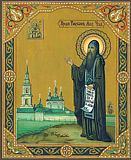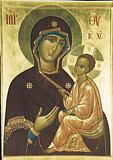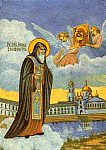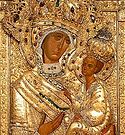

| Previous day | Next day |
| Old Style
June 26
|
Monday |
New Style
July 9
|
|
7th Week after Pentecost.
Tone 5.
Fast of the Holy Apostles. |
Fish, wine and oil allowed.
|
![]() Appearance of the Tikhvin Icon of the Most Holy Theotokos (1383).
Appearance of the Tikhvin Icon of the Most Holy Theotokos (1383). ![]() St. David of Thessalonica (540).
St. David of Thessalonica (540).
St. John, bishop of Gothia in the Crimea (ca. 800). St. Dionysius, archbishop of Suzdal (1385). Uncovering of the relics of St. Tikhon of Lukhov (1569). Translation of the relics of St. Nilus of Stolobny (1995).
Icon of the Most Holy Theotokos “Of Lydda” (1st c.) Icon of the Mother of God “Neamts” (1399). and “Of the Seven Lakes” (Kazan) (17th c.).
St. Brannock (Brynach) of Braunton, England (6th c.). Martyr Pelagius of Cordoba (925). New Martyr David of St. Anne’s Skete, Mt. Athos, at Thessalonica (1813).
Thoughts for Each Day of the Year
According to the Daily Church Readings from the Word of God
By St. Theophan the Recluse

Monday. [I Cor. 5:9-6:11; Matt. 13:54-58]
The Nazarenes did not believe the word of the Lord, because when He lived in amongst them, He had no attractive lustre or outward dignity that would command involuntary respect from all. “We know who He is,” they said; “there can’t be anything extraordinary about Him.” Their reaction, however, did not induce the Lord to assume an imposing appearance. He remained extremely simple in appearance; later the Apostles bore themselves the same way, as did all of those who truly followed and emulated them. Why is this so? Because it is there is no man-made lustre that could fully correspond to the light of life in Jesus Christ. Moreover, we recognize that it is better to relegate external appearance the lowest value, so that it does not block what is within. Let him who has eyes to see look directly at the latter, without arresting his attention upon the former. The holy Apostle Paul expressed it like this: We have this treasure in earthen vessels (II Cor. 4:7). If we could see what was the outward appearance of those persons whom we now revere and call upon in prayer, we would not believe our eyes—they were so simple. But to this day, those who have come to know the life in Jesus Christ abandon care for their outward appearance and turn fully within. That is why the former falls away on its own, but the latter is raised up and grows. It often happens that nobody even notices this inner brightness, not even the one who possesses it. The human eye is evil; it is not shown what is truly good, if this good can harm it.
Articles
 Appearance of the Tikhvin Icon of the Mother of God |
 St David of Thessaloniki |
 St John the Bishop of the Goths in the Crimea |
 St Dionysius the Archbishop of Suzdal |
 Venerable Tikhon of Luchov, KostromaSt Tikhon of Lukh, and Kostroma (in the world Timothy), was born within the bounds of the Lithuanian princedom and was in military service there. |
 Icon of the Mother of God “Neamts” |
 Icon of the Mother of God of Seven LakesThe “Seven Lakes” Icon of the Most Holy Theotokos shone forth with many miracles in the seventeenth century in the area of Kazan. |




